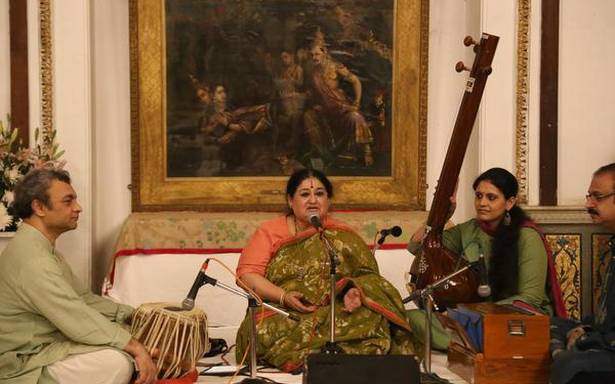Shubha Mudgal performed an unusual concert linking music to painting and weaving
The opulent durbar hall of the Lukshmi Vilas Palace in Baroda was the venue of an unusual event that combined painting, textile weaving and music. A city known for its patronage of art, Maharaja Sayajirao Gaekwad established Baroda’s first music school in February, 1896, and a college of music in the mid-1920s. By the 1930s, the Baroda court boasted the finest musicians. Ustad Faiyaz Khan of the Agra gharana took pride in his Baroda connect. The first all-India music conference, attended by more than 400 musicians and experts, took place here in 1916. This cultural legacy lent more sheen to Shubha Mudgal’s recent concert at the durbar hall, where she rendered songs linked to the theme of five chosen Raja Ravi Varma paintings.
Saris and painting on display at the durbar hall of the Lukshmi Vilas Palace in Baroda. | Photo Credit: Photo: The Hindu Archives
The celebrated Ravi Varma spent 14 years in Baroda and some of his finest works were conceived in the palace studio, which still stands on the grounds. Hyderabad-based designer Gaurang Shah has recreated 34 of these paintings on Jamdani saris.
Gaurang selected 50 paintings, extended the usual loom size to accommodate the fine detailing of each, and managed to have 34 saris ready. Of these, five were hand picked to convey the beauty of the paintings and weaving through music. Shubha Mudgal, in her usual inimitable style, chose appropriate lyrics and raags that suited the time of the day and the event.
The first song, as per tradition, was on Ganesha; the Ravi Varma painting of the elephant-headed god was executed in grey, with an azure base. Shubha chose a composition by a lesser-heard poet from Farrukhabad, in raag Shri, sung during sunset, and taal Rupak. Her powerful voice soared effortlessly, creating the mood for what was to follow.
The second piece, in raag Kalyan (Yaman) was composed by her guru Pt. Ram Ashrey Jha. The song is about how Sita sees Rama’s face for the first time in the reflection from his burnished metal arm bracelet. The painting depicted the breaking of the bow by Rama. The durbar hall, with scenes from the Ramayana painted on its stained glass windows, seemed a perfect venue for the song. Shubha’s third piece was in raag Chayanat and spoke of Sita’s swayamvar. Shubha’s rendition was as detailed as the sari, which had the episode woven into it. Then came a khayal on Devi, in the mid-evening raag Jaijaiwanti, set to Jhaptaal. Apart from taking care to pick appropriate lyrics, the choice of taals too made the concert enjoyable.
The next piece, a thumri, proved Shubha’s versatility. She learnt thumris from Naina Devi, who belonged to the tradition of the legendary thumri exponent Ustad Maujuddin Khan. The painting was of Krishna.
On audience demand, Shubha graciously sang a sixth composition, a chaiti. Every song brought alive the mood and colours of the paintings recreated on six yards of fabric.
The Delhi-based author writes on art and culture.
Source: Read Full Article


